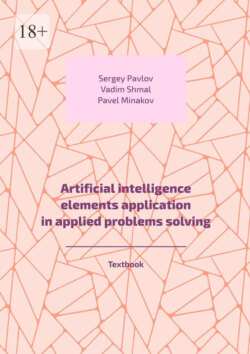Artificial intelligence elements application in applied problems solving. Textbook

Реклама. ООО «ЛитРес», ИНН: 7719571260.
Оглавление
Vadim Shmal. Artificial intelligence elements application in applied problems solving. Textbook
Introduction
What is AI?
AI evolution
AI concept
AI Applications and Capabilities
Simulation intelligence
Knowledge Representation
Logico-linguistic modeling
Semantic heterogeneity
Data Discovery
Frameworks for Model Evaluation
Artificial neural networks
Deep Learning
Overmind
Artificial general intelligence
Artificial intelligence
Artificial intelligence philosophy
Final Sample Sets
AI ethics
Literature
Отрывок из книги
Various subfields of AI research are centered around specific goals and the use of specific tools. Traditional AI research goals include reasoning, knowledge representation, planning, learning, natural language processing, perception. General intelligence (the ability to solve arbitrary tasks) is one of the long-term goals in this area. To solve these problems, AI researchers have adapted and integrated a wide range of problem-solving techniques, including search and mathematical optimization, formal logic, artificial neural networks, and methods based on statistics, probability, and economics. AI also draws on computer science, psychology, linguistics, philosophy, and many other fields. There is no single AI system that solves all problems or solves them effectively.
A key advantage of AI is its ability to solve problems in the real world. But, there are also many potential problems. An important task in the field of AI is to determine which of the possible problems are most likely to be solved with the help of AI, and which require different methods. Some of the main areas that contribute to solving complex AI problems are theory, engineering, and mathematics. While most AI researchers believe that AI will play an important role in future economic and technological development, there are many skeptics. Their skepticism includes concerns about the possible misuse of AI, concerns about its negative impact, and uncertainty about AI’s ability to solve real problems. However, this dispute is not the only one in this area. Many AI researchers believe that it is impossible to predict which tasks will be solved by AI in the future. The reasons for this are that while there are many important problems to be solved in the real world, there is no single mechanism or technology that solves them all.
.....
There are two approaches that can be used to determine the quality of an AI system. One approach is a general approach and does not necessarily make an AI system a great solution. The second approach is called the concrete approach and aims to make the AI system a great solution. In a general approach, the goal is to have AI systems that can handle limited tasks. A specific approach is designed to solve one specific problem.
Each approach has its strengths and weaknesses. For example, a specific approach is better suited for making decisions based on specific requirements. For example, it is better to perform a specific task. The general approach is usually very effective for decision making, but not always effective for solving a specific problem. For example, a general approach can be effective for improving an existing model.
.....